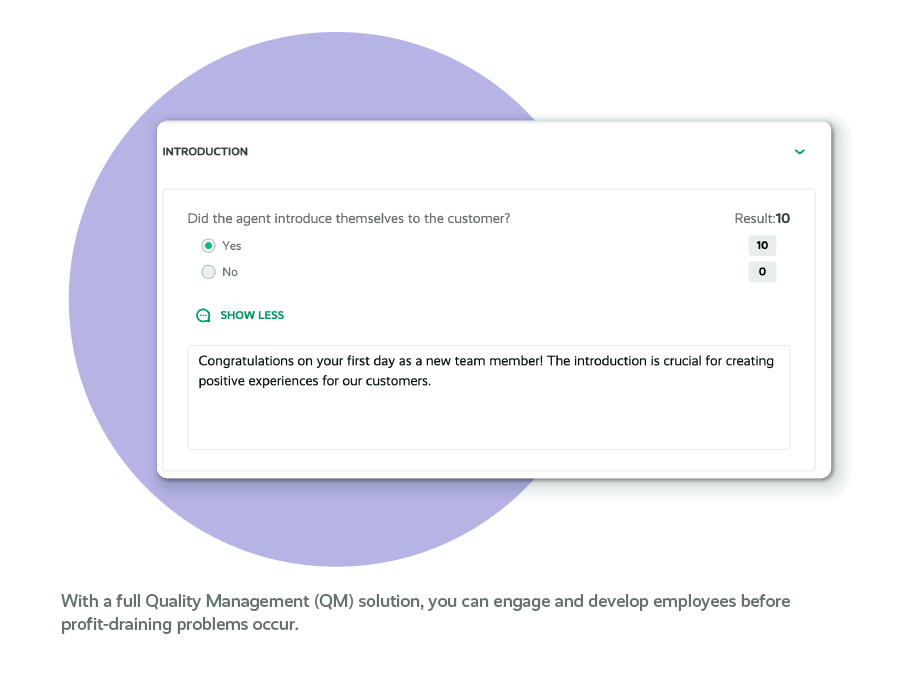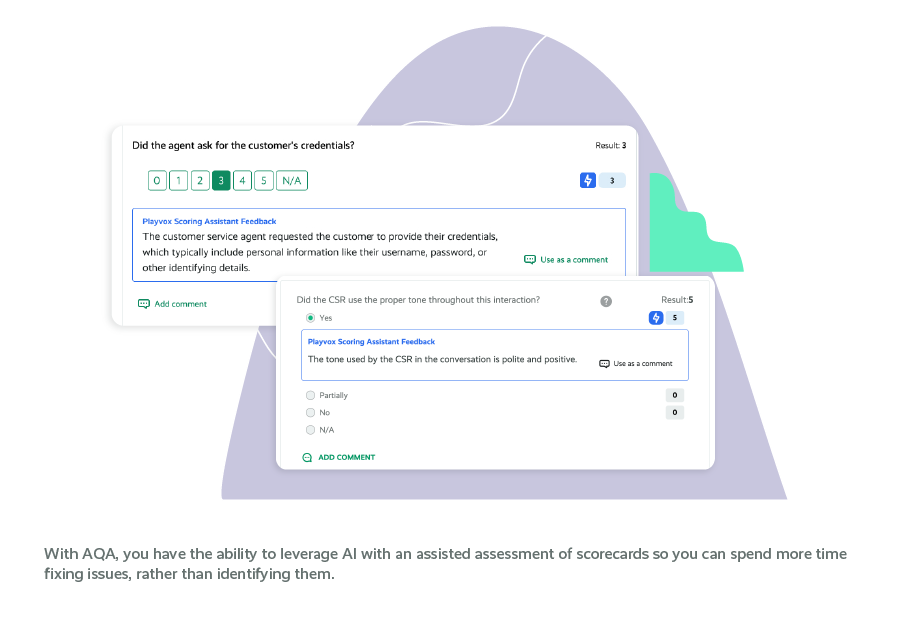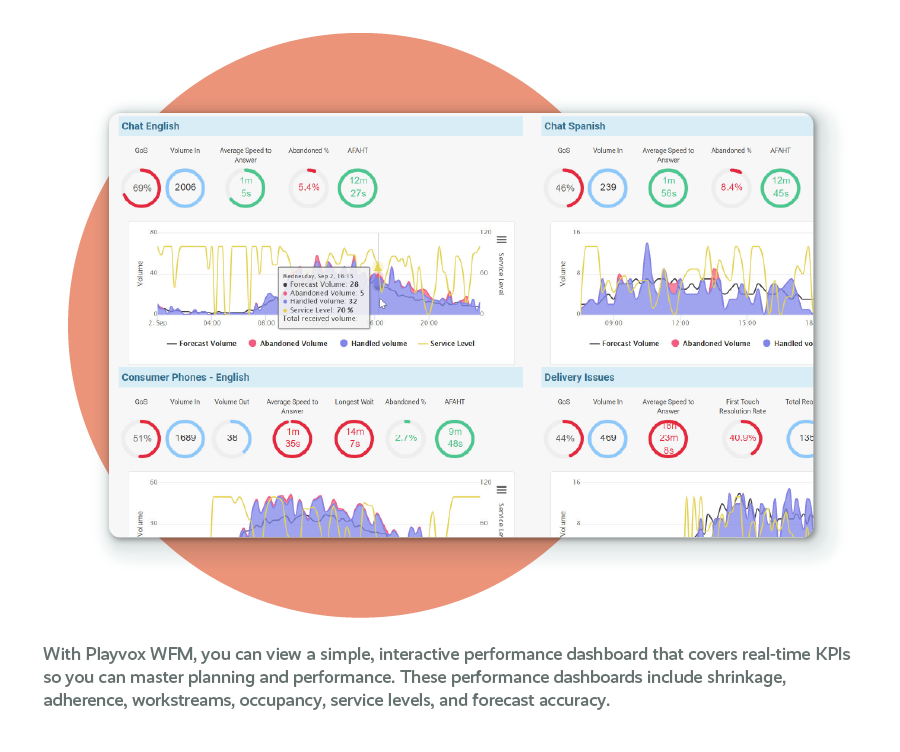Spotting Customer Service Agent Burnout Before It’s Too Late
As anyone who has worked in a contact center can tell you, the environment is both fast-paced and high-pressure. When the expectations from customers are at an all-time high, there can be no greater problem than agent burnout. Burned-out agents are more likely to make mistakes, be disengaged, and, more concerning, provide poor customer service. This can lead to higher turnover rates, decreased productivity, and lower overall customer satisfaction – at a time when customer experience matters more than ever.
Before we dive into ways you can not just identify, but also turn around call center agent burnout, let’s first discuss what agent burnout is and how you can identify when your agents are teetering on the edge of less-than-optimal mental well-being.

What is Agent Burnout?
In the majority of customer service centers, agents need to navigate a constant barrage of customer inquiries and solve problems on-the-fly all while meeting tight deadlines, like a service level agreement (SLA) that demands that 80% of all interactions are solved during the first contact. This relentless pressure can lead to a phenomenon known as agent burnout — a state of physical, emotional, and mental exhaustion.
Employees experiencing burnout may find that it is difficult to engage in activities they once found meaningful. For example, an agent who was once active in mentoring other customer service representatives may not want to continue this kind of activity. Agent burnout may also mean that your employee may no longer care about the things that they once found important, or, experience an increasing sense of hopelessness.
Reasons for Agent Burnout
Burnout can occur for many reasons — the very act of working in a contact center can cause a great deal of stress. But, there are additional factors that may cause one contact center environment to be more stressful than another.
1. Little or No Feedback on Performance
As humans, we are built for human connection. According to Brene Brown, “Connection is the energy that exists between people when they feel seen, heard, and valued; when they can give and receive without judgment; and when they can derive sustenance and strength from the relationship.”
If we take this concept of human connection a bit further, we can think about the gift of feedback. When you provide feedback – whether it is favorable or not – you validate someone doing something well or provide tangible examples of how they can do something better. Not receiving timely and actionable feedback can lead to increased levels of agent burnout.
2. Inconsistent Staffing Levels
It is an age-old battle in contact centers — making sure there is adequate staff to meet and/or exceed SLAs, while also meeting budget expectations. When a contact center is over-staffed, agents may become bored at best, and may not be able to think quickly on their feet at worst. If a service center is understaffed, agents may feel the need to rush each customer interaction in an attempt to get to the next call, text, or email that is demanding their attention. Both under- and over-staffing can contribute to call center agent burnout.
3. Leaders Who Are Out-of-Touch with the Realities of Working in a Contact Center
As mentioned, working in a customer service role in a contact center is stressful. However, not everyone understands the difficulties in solving customer issues day in and day out. When an executive makes an off-hand remark such as, “How hard can it be to get through inquiries quickly?” it can deflate and de-motivate even the most positive contact center employee, inadvertently leading to burnout.
4. Little Opportunity to Learn, Grow, or Progress at the Company
It can be discouraging to do the same tasks over and over, day after day. However, many employees can be satisfied with this type of repetition if they have a career plan and their manager has mapped out ways they can move up in the organization. Without any type of career pathing, agents can easily become frustrated.
5. Little Focus on Agent Well-Being
As those who have been in contact centers know, they can be intense. Interactions are constant and the push to hit SLAs is never-ending. In this environment, mental health can take a back seat as supervisors and team leads focus on agent performance. When leaders do not take care of the entire agent – particularly mental health – agents can easily become disengaged and ultimately, burnt out.
Mitigating and Preventing Agent Burnout
Now that we have addressed why customer service agents may become disengaged, let’s talk through actionable ways you can mitigate and prevent customer service agent burnout.
1. Prioritize Feedback
We all want feedback — affirmation that we are doing a good job or tips on how we can be more effective. This means that no matter how busy your contact center may become, you must make time for giving and receiving feedback. Leveraging a Quality Management (QM) solution, can help you do this in a consistent fashion.

Establishing consistent QM is an absolute necessity at contact centers to provide that feedback your agents want and desire. While typical Quality Management systems and processes may require a fair amount of manual intervention, along with time and resources, leading companies have found that they can automate this process with AutoQA (AQA).

2. Leverage a Workforce Management Solution for Consistent Staffing Levels
Forecasting contact center requirements is often incredibly difficult, especially if you are forced to do this manually on spreadsheets. WFM teams may need to create complex formulas to identify peak hours, holiday or seasonal trends, or the impact of a marketing promotion on contact center volumes.
Once you have a forecast, you have even more complexity because you then need to match it to the needs and wants of your agent teams. Some team members may require only morning hours, others may need to leave early to collect children from school or childcare, and still others may have requirements to work only particular days or hours that change and shift week-to-week.
Doing all of this manually can result in over- or under-staffing, which comes with its own set of problems. When contact centers are either under-or over-staffed, agents can easily become disengaged and frustrated about the lack of consistency in their work patterns and schedules.
But, it doesn’t need to be this hard to create a forecast and staffing model. When you leverage a WFM solution, you can automate the entire process of forecasting, scheduling, and even long-range capacity planning. You can then make sure what you built out is working as planned with real-time adherence tracking.

Together, automating all the pieces of managing your contact center team lets you meet your organization’s SLAs, while also making sure staffing levels are consistent. This, in turn, helps your agents to be more productive and engaged since they aren’t battling boredom or an inability to keep up.
3. Ensure All Leaders Spend Time on the Front Lines
Similar to a Monday morning quarterback, who can easily second-guess the choices the coach or quarterback made during a Sunday football game, it can be easy for leaders to become out-of-touch with the day-to-day realities of a contact center.
A quick cure for this is to schedule leaders to sit side-by-side with agents to hear and see the issues that are consistently coming up. In a remote work situation, leaders can achieve the same outcome by employing technology to see or listen to calls or interactions.
4. Create Individual Development Plans (IDPs) for Agents
When agents feel like they will be doing the same repetitive tasks, day-after-day, week-after-week, and month-after-month, it can lead to not just disengagement and poor customer service, but can also lead them to seek opportunities elsewhere. A solution for this is to put an IDP in place for every employee. An IDP doesn’t need to be complicated, or promise any sort of promotion or other job shift. What it can do is give each employee a clear idea of the skills and experience they need to develop to move up in the organization.
5. Prioritize Agent Well-Being
It may seem obvious that employees who are struggling with their mental health will not give your organization their all because often they are simply unable to do so. That makes it critical when you do weekly check-ins to ask questions about how they are doing. And this goes beyond a simple “how are you?” as many of us are trained to respond with “I’m fine.” To dig deeper, you can ask questions like:
- Tell me what went well this week. Tell me what didn’t.
- Can you share a few difficult interactions that happened this week? How can I help you after that happens?
- Is there anything happening outside of work that is making it difficult to focus on work right now?
- Are you frustrated by a process or procedure in our contact center? How can I help make it better?
For additional ideas on improving your agents’ mental well-being, check out this blog.
Customer Service Agent Burnout: Stop It Before It Happens
Left unchecked, burnout not only affects individual agents but also impacts overall contact center performance and customer satisfaction. If you can identify signs of burnout early, you can turn things around and have happier employees, and ultimately, better customer experiences.
By providing adequate resources, fostering a supportive culture, and offering training and development opportunities, contact center managers can help prevent agent burnout and create a positive work environment where agents can thrive.
Interested in learning more about preventing agent burnout? Download our free e-book Cracking the Code: How to Identify and Address Agent Disengagement.







